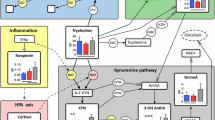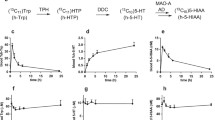Abstract
Hepatic encephalopathy is a frequent complication of cirrhosis. Abnormalities of5-hydroxytryptamine (5-HT) and its metabolites are recognized and may contribute to its pathogenesis. We therefore studied the effect of an oral tryptophan load (6–18 g) upon psychometric test scores and analyzed EEG's in alcoholic cirrhotic patients. Eight patients had had previous encephalopathic episodes related to variceal bleeds and one patient was awaiting a liver transplant. Five out of the 10 patients had at least one abnormal baseline psychometric test. Following tryptophan challenge there were no changes in blood ammonia but plasma tryptophan levels were elevated approximately 10-fold (p <0.01× 10−7). Nevertheless, there were no statistically significant changes in psychometric testing or analyzed EEG frequency distribution. All patients reported nausea or vomiting while one patient developed a short-lived serotonin like syndrome. We conclude that in this group of patients, an oral tryptophan load does not induce or worsen subclinical hepatic encephalopathy. If the high blood levels of tryptophan seen in these studies are able to influence cerebral neurotransmitter synthesis, the results do not support a primary role for abnormalities of 5-HT neurotransmission in hepatic encephalopathy.
Similar content being viewed by others
References
Al Mardini, H., Douglass, A., and Record, C.O. (2001). Amino acid challenge in patients with cirrhosis and control subjects: Serum amino acid and EEG changes. Hepatology 34:547A.
Al Mardini, H.A., Harrison, E., Ince, P., Bartlett, K., and Record, C.O. (1993). Brain indoles in human hepatic encephalopathy. Hepatology 17:1033-1040.
Apelqvist, G., Wikell, C., Carlsson, B., Hjorth, S., Bergqvist, P.B., Ahlner, J., Bengtsson, F. (2000). Dynamic and kinetic effects of chronic citalopram treatment in experimental hepatic encephalopathy. Clin. Neuropharmacol. 23:304-317.
Aschroft, G.W., Eccleston, D., and Crawford, T.B.B. (1965). 5-Hydroxyindole metabolism in rat brain. A study of intermediate metabolism using the technique of tryptophan loading-I Methods. J. Neurochem. 12:483-492.
Bergqvist, P.B.F., Hjorth, S., Apelqvist, G., and Bengtsson, F. (1996). Acute effects of L-tryptophan on brain extracellular 5HT and 5HIAA in chronic experimental portal-systemic encephalopathy. Metab. Brain Dis. 11:269-278.
Douglass, A., Al Mardini, H., and Record, C.O. (2001). Amino acid challenge in patients with cirrhosis: A model for the assessment of treatments for hepatic encephalopathy. J. Hepatol. 34:658-664.
Frewer, L.J., and Hindmarch, I. (1988). The effects of time of day, age and anxiety on a choice reaction task. In (I. Hindmarch, B. Aufdembrinke, and H. Ott, eds.), Psychopharmacology and Reaction Time, John Wiley and Sons, Chichester, England, pp. 103-114.
Grahame-Smith, D.G. (1973). Does the total turnover of brain 5HT reflect the functional activity of 5HT in the brain. In (J. Barchas, and E. Usdin, eds.), Serotonin Behaviour, Academic Press, New York, pp. 5-7.
Groeneweg, M., Quero, J.C., De Bruijn, I., Hartmann, I.J., Essink-Bot, M.L., Hop, W.C.J., and Schalm, S.W. (1998). Subclinical hepatic encephalopathy impairs daily functioning. Hepatology 28:45-49.
Hirayami, C. (1971). Tryptophan metabolism in liver disease. Clin. Chim. Acta. 32:191-197.
Holm, E., Jacob, S., Kortsik, C., Leweling, H., and Fischer, B. (1988). Failure of selective serotonin reuptake inhibition to worsen the mental state of patients with subclinical hepatic encephalopathy. In (P.B. Soeters, J.H.P. Wilson, A.J. Meijer, and E. Holm, eds.), Advances in Ammonia Metabolism and Hepatic Encephalopathy, Elsevier, Amsterdam, pp. 474-486.
Loguercio, L., del Vecchio Blanco, M., and Coltorti, M. (1990). Oral ammonia load in well-compensated cirrhosis: Effect on psychometric tests. In (F. Bengtsson, B. Jeppson, T. Almdal, and H. Vilstrup, eds.), Progress in Hepatic Encephalopathy and Metabolic Nitrogen Exchange, CRC Press, London, pp. 83-89.
Matousek, M., Arvidsson, A., and Friberg, S. (1978). Implementation of analytical methods in daily clinical EEG. In (W.A. Cobb and H. van Duijn, eds.), Contemporary Clinical Neurophysiology. pp. 199-204. Electroenceph. Clin. Neurophysiol. (Supp. 34).
Moore, J.W., Dunk, A.A., Crawford, J.R., Deans, H., Besson, J.A., De Lacey, G. and Sinclair, T.S. (1989). Neuropsychological defects and morphological MRI brain scan abnormalities in apparently healthy non-encephalopathic patients with cirrhosis. Hepatology 9:319-325.
Moroni, F., Lombardi, G., Carla, V., Lal, S., Etienne, P., and Nair, P.V. (1986). Increase in the content of Quinolinic acid in the CSF and frontal cortex of patients with hepatic encephalopathy. J. Neurochem. 47: 1667-1671.
Oppong, K.N., Al Mardini, H., Thick, M., and Record, C.O. (1997). Oral glutamine challenge in cirrhotics pre-and post-liver transplantation: A psychometric and analyzed EEG study. Hepatology 26:870-876.
Prior, P.F., and Maynard, D.E. (1986). Monitoring Cerebral Function. Long Term Monitoring of EEG and Evoked Potentials. Elsevier, Amsterdam.
Rees, C.J., Oppong, K.N., Al-Mardini, H., Hudson, M., and Record, C.O. (2000). Effect of l-ornithine-aspartate on patients with and without TIPS undergoing glutamine challenge: A double blind placebo controlled trial. Gut 47:571-574.
Rikkers, L., Jenko, P., Rudman, D., and Freides, D. (1978). Subclinical hepatic encephalopathy detection, prevalence and relationship to nitrogen metabolism. Gastroenterology 75:462-469.
Salerno, F., Delloco, M., Incerti, P., Uggeri, F., and Beretta, E. (1984). Alterations of plasma and brain tryptophan in hepatic encephalopathy: A study in humans and experimental animals. In (L. Capocaccia, J.E. Fischer, and F. Rossi-Fanelli). Hepatic Encephalopathy in Chronic Liver Failure, Plenum, New York, pp. 95-106.
Ternaux, J.P., Boireau, A., Bourgoin, S., Hamon, M., Hery, F., and Glowinski, J. (1976). In vivo release of 5HT in the lateral ventricle of the rat: Effects of 5 hydoxytryptophan. Brain Res. 101:533-548.
Wechsler, D. (1981). WAIS-R Manual, Psychological Corporation, New York.
Weissenborn, K., Ennen, J., Schomerus, H., Ruckert, N., and Hecker, H. (2001). Neuropsychological characterization of hepatic encephalopathy. J. Hepatol. 34:768-773.
Young, S.N., Lal, S., Sourkes, T.L., Feldmuller, F., Aronoff, A., and Martin, J.B., et al. (1975). Relationships between tryptophan in serum and CSF, and 5-hydroxyindoleacetic acid in CSF of man: Effect of cirrhosis of liver and probenecid administration. J. Neurol. Neurosurg. Psychiatly. 38:322-330.
Author information
Authors and Affiliations
Rights and permissions
About this article
Cite this article
Douglass, A., Mardini, H.A. & Record, C.O. Oral Tryptophan Challenge Studies in Cirrhotic Patients: No Evidence of Neuropsychiatric Changes. Metab Brain Dis 18, 179–186 (2003). https://doi.org/10.1023/A:1025577614928
Issue Date:
DOI: https://doi.org/10.1023/A:1025577614928




